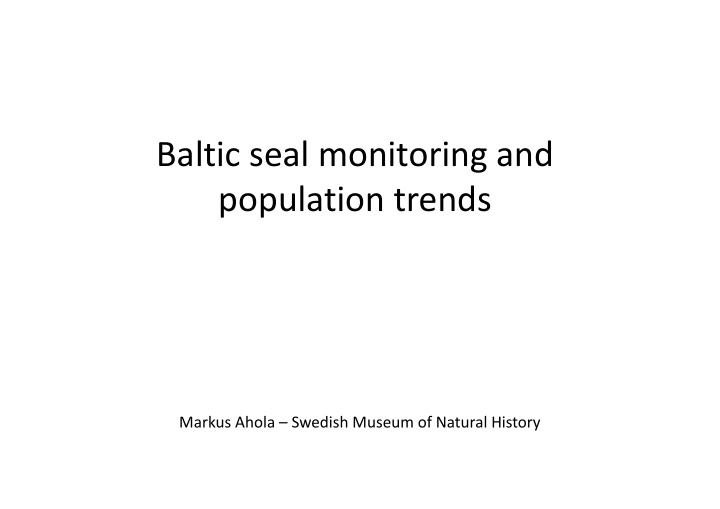



Baltic seal monitoring and population trends Markus Ahola – Swedish Museum of Natural History
Seals’ annual cycle • Grey seal and ringed seal pups are born in February-March, harbour seal pups in June, lactation period 3-6 weeks • In the end of lactation period mating for the next reproduction takes place • Moulting - RS: April-May, GS: May-June, HS: August) • From moult to next breeding season: foraging, resting, travelling, gathering a fit condition for next breeding and winter • Delayed implantation of the embryo a couple of months after moult
History of seal populations in the Baltic • High hunting pressure & bounty practises lead to population crash in early 1900’s • After the largest crash environmental contaminants such as PCB caused low reproductive success and prevented the populations to recover Harding & Härkönen, Ambio 1999
Current monitoring methods for abundance and distribution Based on aerial surveys during • peak moulting period – Ringed seal after mid-April – Grey seal in late May - early June – Harbour seal in mid-August Moult is the time when seals spend • largest proportion of their time hauling out on land or ice and are available for counting The monitoring in Baltic is • internationally coordinated among people in HELCOM SEAL EG
Grey seal Grey seals gather to islets and skerries in outer archipelago • and coastal zone All haulouts are surveyed annually 2-3 times within a • commonly agreed two-week period in the end of May- beginning of June, new locations searched during the surveys The groups of seals are photographed and their numbers • are counted from the photos The largest daily result for each sea area is used as the • abundance index 240
Grey seal abundance trends Abundance index in 2017 30 000 and average annual increase +4.9 %/v 2 000 (%/year) during 2003-2017 +3.9 % The whole Baltic ~ 30 000, 60-80 % of the 2 100 total population size of +9.0 % 37 500 – 50 000. 8 100 +0.9 % Geographically 800 describes the +1.0 % 11 100 situation during +8.1 % 4 000 the peak moult! +3.8 % 2 600 +20.6 %
Harbour seal Two-three aerial surveys covering all haulout sites within two weeks in August • Seals are photographed and number of individuals are counted from the • photographs Abundance index, ”a trimmed mean” = average of two largest daily results •
Harbour seal abundance trends Abundance index in Four management units: 2016 and increase - Kattegat, Skagerrak, Kalmarsund (average %/v) during ja Southern Baltic 2005-2016 6 500 +7.5 % Abundance index estimated to represent 65 % of total population size. 10 500 900 ⇒ Total population sizes: +6.9 % +6.9 % Skagerrak 10 000 Kattegat 16 000 900 Southern Baltic 1 400 +7.8 % Kalmarsund 1 400
Ringed seal Bothnian Bay: • – Aerial transect line methodology – Transects evenly spread over the ice- covered area – Flying altitude 90 m, survey strips 400 m on both sides – Survey strips give a sample of min 13 % of the ice-covered area – All seals on the survey strips are photographed and counted from the photos – The number is multiplied from the sample to the whole area – The result is used as abundance index Härkönen & Lunneryd, Ambio 1992
Ringed seal • The Archipelago Sea, Gulf of Finland and Western Estonia: – Aerial surveys possible only on good enough ice-years – In the Archipelago Sea the whole area between the transect lines is observed – Monitoring methods for ice-free circumstances under development
Ringed seal trends Two management units: - Bothnian Bay - The Archipelago Sea, Gulf of Finland and W- > 20 000 Estonia Annual increase for Bothnian Bay population in 1988-2016: on average 4,5 %/year ~200-300 ~100 ~1 000 In other areas: no increase
Recommend
More recommend